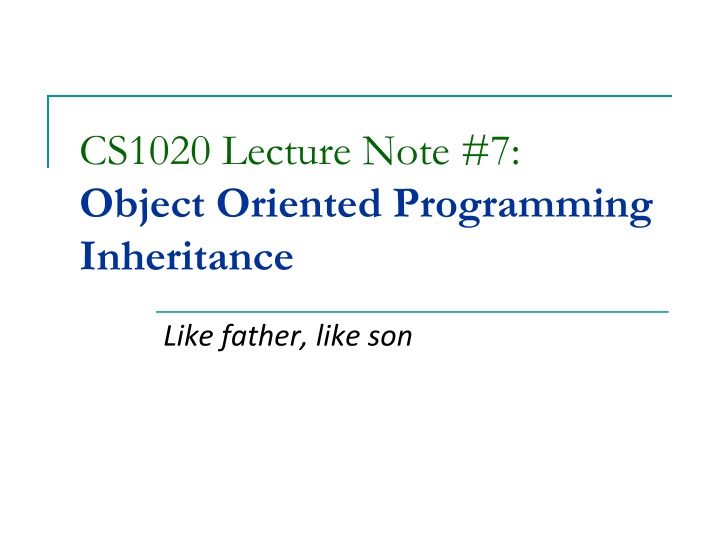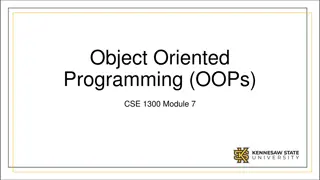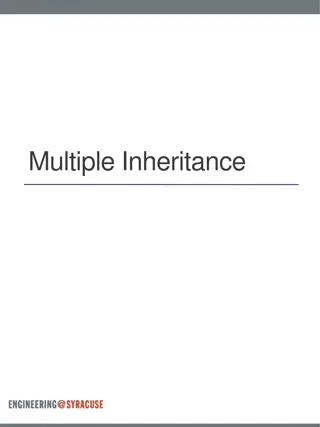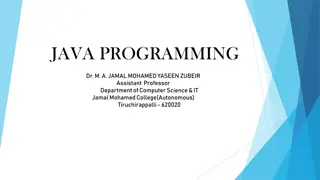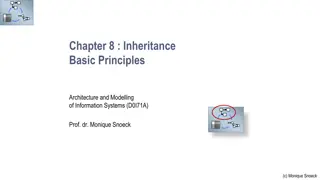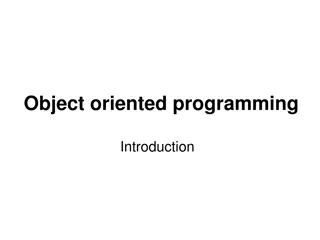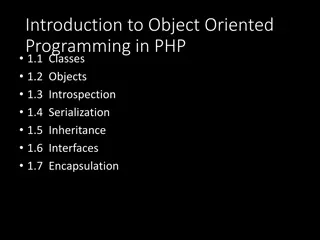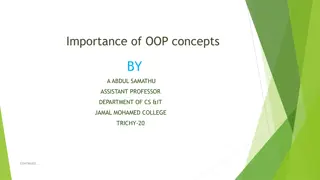Object Oriented Programming and Inheritance Concepts
Introducing inheritance in object-oriented programming, allowing subclasses to inherit properties and behaviors from existing classes. Explore overriding methods, creating subclasses, and understanding the core concepts of OOP like encapsulation, abstraction, and polymorphism.
Download Presentation

Please find below an Image/Link to download the presentation.
The content on the website is provided AS IS for your information and personal use only. It may not be sold, licensed, or shared on other websites without obtaining consent from the author.If you encounter any issues during the download, it is possible that the publisher has removed the file from their server.
You are allowed to download the files provided on this website for personal or commercial use, subject to the condition that they are used lawfully. All files are the property of their respective owners.
The content on the website is provided AS IS for your information and personal use only. It may not be sold, licensed, or shared on other websites without obtaining consent from the author.
E N D
Presentation Transcript
CS1020 Lecture Note #7: Object Oriented Programming Inheritance Like father, like son
Objectives Introducing inheritance through creating subclasses Improve code reusability Allowing overriding to replace the implementation of an inherited method [CS1020 Lecture 7: Inheritance] 2
References Textbook Chapter 1: Section 1.4 (pg 54 56) Chapter 9: Section 29.1 (pg 480 490) http://www.comp.nus.edu.sg/ ~cs1020/2_resources/lectures.html CS1020 website Resources Lectures http://www.comp.nus.edu.sg/ ~cs1020/2_resources/lectures.html http://www.comp.nus.edu.sg/ ~cs1020/2_resources/lectures.html http://www.comp.nus.edu.sg/ ~cs1020/2_resources/lectures.html [CS1020 Lecture 7: Inheritance] 3
Outline 1. Overriding Methods (revisit) 2. Creating a Subclass 2.1 Observations 2.2 Constructors in Subclass 2.3 The super Keyword 2.4 Using SavingAcct 2.5 Method Overriding 2.6 Using super Again 3. Subclass Substitutability 4. The Object Class 5. is-a versus has-a 6. Preventing Inheritance ( final ) 7. Constraint of Inheritance in Java 8. Quick Quizzes [CS1020 Lecture 7: Inheritance] 4
0. Object-Oriented Programming Four fundamental concepts of OOP: Encapsulation Abstraction Inheritance Polymorphism Inheritance allows new classes to inherit properties of existing classes Main concepts in inheritance Subclassing Overriding [CS1020 Lecture 7: Inheritance] 5
1. Overriding Methods (revisit) (1/2) Recall in lecture #4 that a user-defined class automatically inherits some methods such as toString() and equals() from the Object class The Object class is known as the parent class (or superclass); it specifies some basic behaviours common to all kinds of objects, and hence these behaviours are inherited by all its subclasses (derived classes) However, these inherited methods usually don t work in the subclass as they are not customised [CS1020 Lecture 7: Inheritance] 6
1. Overriding Methods (revisit) (2/2) Hence, to make them work, we customised these inherited methods this is called overriding Lecture #4: MyBall/MyBall.java /***************** Overriding methods ******************/ // Overriding toString() method public String toString() { return "[" + getColour() + ", " + getRadius() + "]"; } // Overriding equals() method public boolean equals(Object obj) { if (obj instanceof MyBall) { MyBall ball = (MyBall) obj; return this.getColour().equals(ball.getColour()) && this.getRadius() == ball.getRadius(); } else return false; } } [CS1020 Lecture 7: Inheritance] 7
2. Creating a Subclass (1/6) Object-oriented languages allow inheritance Declare a new class based on an existing class So that the new class may inherit all of the attributes and methods from the other class Terminology If class B is derived from class A, then class B is called a child (or subclass or derived class) of class A Class A is called a parent (or superclass) of class B [CS1020 Lecture 7: Inheritance] 8
2. Creating a Subclass (2/6) Recall the BankAcct class in lecture #4 lect4/BankAcct.java class BankAcct { private int acctNum; private double balance; public BankAcct() { } public BankAcct(int aNum, double bal) { ... } public int getAcctNum() { ... } public double getBalance() {... } public boolean withdraw(double amount) { ... } public void deposit(double amount) { ... } public void print() { ... } } [CS1020 Lecture 7: Inheritance] 9
2. Creating a Subclass (3/6) Let s define a SavingAcct class Basic information: Account number, balance Interest rate New requirements Basic functionality: Withdraw, deposit Pay interest Compare with the basic bank account: Differences are highlighted above SavingAcct shares more than 50% of the code with BankAcct So, should we just cut and paste the code from BankAcct to create SavingAcct? [CS1020 Lecture 7: Inheritance] 10
2. Creating a Subclass (4/6) Duplicating code is undesirable as it is hard to maintain Need to correct all copies if errors are found Need to update all copies if modifications are required Since the classes are logically unrelated if the codes are separated: Code that works on one class cannot work on the other Compilation errors due to incompatible data types Hence, we should create SavingAcct as a subclass of BankAcct [CS1020 Lecture 7: Inheritance] 11
2. Creating a Subclass (5/6) BankAcct.java class BankAcct { protected int acctNum; protected double balance; //Constructors and methods not shown The protected keyword allows subclass to access the attributes directly } The extends keyword indicates inheritance class SavingAcct extends BankAcct { protected double rate; // interest rate public void payInterest() { balance += balance * rate; } This allows subclass of SavingAcct to access rate. If this is not intended, you may change it to private . } SavingAcct.java [CS1020 Lecture 7: Inheritance] 12
2. Creating a Subclass (6/6) The subclass-superclass relationship is known as an is-a relationship, i.e. SavingAcct is-a BankAcct In the UML diagram, a solid line with a closed unfilled arrowhead is drawn from SavingAcct to BankAcct The symbol # is used to denoted protected member SavingAcct BankAcct # acctNum # balance # rate + getRate() + payInterest() + print() + getAcctNum() + getBalance() + withdraw() + deposit() + print() [CS1020 Lecture 7: Inheritance] 13
2.1 Observations Inheritance greatly reduces the amount of redundant coding In SavingAcct class, No definition of acctNum and balance No definition of withdraw() and deposit() Improve maintainability: Eg: If a method is modified in BankAcct class, no changes are needed in SavingAcct class The code in BankAcct remains untouched Other programs that depend on BankAcct are unaffected very important! [CS1020 Lecture 7: Inheritance] 14
2.2 Constructors in Subclass Unlike normal methods, constructors are NOT inherited You need to define constructor(s) for the subclass class SavingAcct extends BankAcct { protected double rate; // interest rate public SavingAcct(int aNum, double bal, double rate){ acctNum = aNum; balance = bal; this.rate = rate; } //......payInterest() method not shown } SavingAcct.java [CS1020 Lecture 7: Inheritance] 15
2.3 The super Keyword The super keyword allows us to use the methods (including constructors) in the superclass directly If you make use of superclass constructor, it must be the first statement in the method body class SavingAcct extends BankAcct { protected double rate; // interest rate public SavingAcct(int aNum, double bal, double rate){ super(aNum, bal); this.rate = rate; } Using the constructor in BankAcct class //......payInterest() method not shown } SavingAcct.java [CS1020 Lecture 7: Inheritance] 16
2.4 Using SavingAcct TestSavingAcct.java public class TestSavingAcct { public static void main(String[] args) { SavingAcct sa1 = new SavingAcct(2, 1000.0, 0.03); sa1.print(); sa1.withdraw(50.0); Inherited method from BankAcct Method in SavingAcct sa1.payInterest(); sa1.print(); } } How about print()? Should it be the one in BankAcct class, or should SavingAcct class override it? [CS1020 Lecture 7: Inheritance] 17
2.5 Method Overriding (1/2) Sometimes we need to modify the inherited method: To change/extend the functionality As you already know, this is called method overriding In the SavingAcct class: The print() method inherited from BankAcct should be modified to include the interest rate in output To override an inherited method: Simply recode the method in the subclass using the same method header Method header refers to the name and parameters type of the method (also known as method signature) [CS1020 Lecture 7: Inheritance] 18
2.5 Method Overriding (2/2) SavingAcct.java class SavingAcct extends BankAcct { protected double rate; // interest rate public double getRate() { return rate; } public void payInterest() { ... } public void print() { System.out.println("Account Number: " + getAcctNum()); System.out.printf("Balance: $%.2f\n", getBalance()); System.out.printf("Interest: %.2f%%\n", getRate()); } } The first two lines of code in print() are exactly the same as print() of BankAcct Can we reuse BankAcct s print() instead of recoding? [CS1020 Lecture 7: Inheritance] 19
2.6 Using super Again The super keyword can be used to invoke superclass method Useful when the inherited method is overridden SavingAcct.java class SavingAcct extends BankAcct { . . . To use the print() method from BankAcct public void print() { super.print(); System.out.printf("Interest: %.2f%%\n", getRate()); } } [CS1020 Lecture 7: Inheritance] 20
3. Subclass Substitutability (1/2) An added advantage for inheritance is that: Whenever a super class object is expected, a sub class object is acceptable as substitution! Caution: the reverse is NOT true (Eg: A cat is an animal; but an animal may not be a cat.) Hence, all existing functions that works with the super class objects will work on subclass objects with no modification! Analogy: We can drive a car Honda is a car (Honda is a subclass of car) We can drive a Honda [CS1020 Lecture 7: Inheritance] 21
3. Subclass Substitutability (2/2) TestAcctSubclass.java public class TestAcctSubclass { public static void transfer(BankAcct fromAcct, BankAcct toAcct, double amt) { fromAcct.withdraw(amt); toAcct.deposit(amt); }; public static void main(String[] args) { BankAcct ba = new BankAcct(1, 234.56); SavingAcct sa = new SavingAcct(2, 1000.0, 0.03); transfer(ba, sa, 123.45); ba.print(); sa.print(); } } transfer() method can work on the SavingAcct object sa! [CS1020 Lecture 7: Inheritance] 22
4. The Object Class In Java, all classes are descendants of a predefined class called Object Object class specifies some basic behaviors common to all objects Any methods that works with Object reference will work on object of any class Methods defined in the Object class are inherited in all classes Two inherited Object methods are toString() method equals() method However, these inherited methods usually don t work because they are not customised [CS1020 Lecture 7: Inheritance] 23
5. is-a versus has-a (1/2) Words of caution: Do not overuse inheritance Do not overuse protected Make sure it is something inherent for future subclass To determine whether it is correct to inherit: Use the is-a rules of thumb If B is-a A sounds right, then B is a subclass of A Frequently confused with the has-a rule If B has-a A sounds right, then B should have an A attribute (hence B depends on A) [CS1020 Lecture 7: Inheritance] 24
5. is-a versus has-a (2/2) UML diagrams class BankAcct { ... } SavingAcct BankAcct class SavingAcct extends BankAcct { ... } Solid arrow Inheritance: SavingAcct IS-A BankAcct class BankAcct { ... }; Person BankAcct class Person { private BankAcct myAcct; }; Attribute: Person HAS-A BankAcct [CS1020 Lecture 7: Inheritance] Dotted arrow 25
6. Preventing Inheritance (final) Sometimes, we want to prevent inheritance by another class (eg: to prevent a subclass from corrupting the behaviour of its superclass) Use the final keyword Eg: final class SavingAcct will prevent a subclass to be created from SavingAcct Sometimes, we want a class to be inheritable, but want to prevent some of its methods to be overridden by its subclass Use the final keyword on the particular method: public final void payInterest() { } will prevent the subclass of SavingAcct from overriding payInterest() [CS1020 Lecture 7: Inheritance] 26
7. Constraint of Inheritance in Java Single inheritance: Subclass can only have a single superclass Multiple inheritance: Subclass may have more than one superclass In Java, only single inheritance is allowed (Side note: Java s alternative to multiple inheritance can be achieved through the use of interfaces to be covered later. A Java class may implement multiple interfaces.) [CS1020 Lecture 7: Inheritance] 27
8. Quick Quiz #1 (1/2) ClassA.java class ClassA { protected int value; ClassA # value public ClassA() { } + print() public ClassA(int val) { value = val; } public void print() { System.out.println("Class A: value = " + value); } } ClassB # value + print() class ClassB extends ClassA { protected int value; public ClassB() { } public ClassB(int val) { super.value = val 1; value = val; } public void print() { super.print(); System.out.println("Class B: value = " + value); } } ClassB.java [CS1020 Lecture 7: Inheritance] 28
8. Quick Quiz #1 (2/2) ClassA # value ClassC.java + print() final class ClassC extends ClassB { private int value; public ClassC() { } ClassB # value public ClassC(int val) { super.value = val 1; value = val; } + print() public void print() { super.print(); System.out.println("Class C: value = " + value); } } ClassC - value What is the output? + print() public class TestSubclasses { public static void main(String[] args) { ClassA objA = new ClassA(123); ClassB objB = new ClassB(456); ClassC objC = new ClassC(789); objA.print(); System.out.println("---------"); objB.print(); System.out.println("---------"); objC.print(); } } TestSubclasses.java [CS1020 Lecture 7: Inheritance] 29
8. Quick Quiz #2 (1/2) A + m() + n() Assume all methods print out message of the form <class name>,<method name> Eg: method m() in class A prints out A.m . B C If a class overrides an inherited method, the method s name will appear in the class icon. Otherwise, the inherited method remains unchanged in the subclass. + n() + p() + m() D For each code fragment below, indicate whether: The code will cause compilation error, and briefly explain; or The code can compile and run. Supply the execution result. + m() + n() + p() Code fragment (example) A a = new A(); a.m(); A a = new A(); a.k(); Compilation error? Why? Execution result A.m Method k() not defined in class A [CS1020 Lecture 7: Inheritance] 30
8. Quick Quiz #2 (2/2) A + m() + n() Code fragment A a = new C(); a.m(); B b = new A(); b.n(); A a = new B(); a.m(); A a; C c = new D(); a = c; a.n(); B b = new D(); b.p(); C c = new C(); c.n(); A a = new D(); a.p(); Compilation error? Execution result B C + n() + p() + m() D + m() + n() + p() [CS1020 Lecture 7: Inheritance] 31
Summary Inheritance: Creating subclasses Overriding methods Using super keyword The Object class [CS1020 Lecture 7: Inheritance] 32
Practice Exercise Practice Exercises #22: Create a subclass CentredCircle from a given class Circle #23: Manage animals [CS1020 Lecture 7: Inheritance] 33
